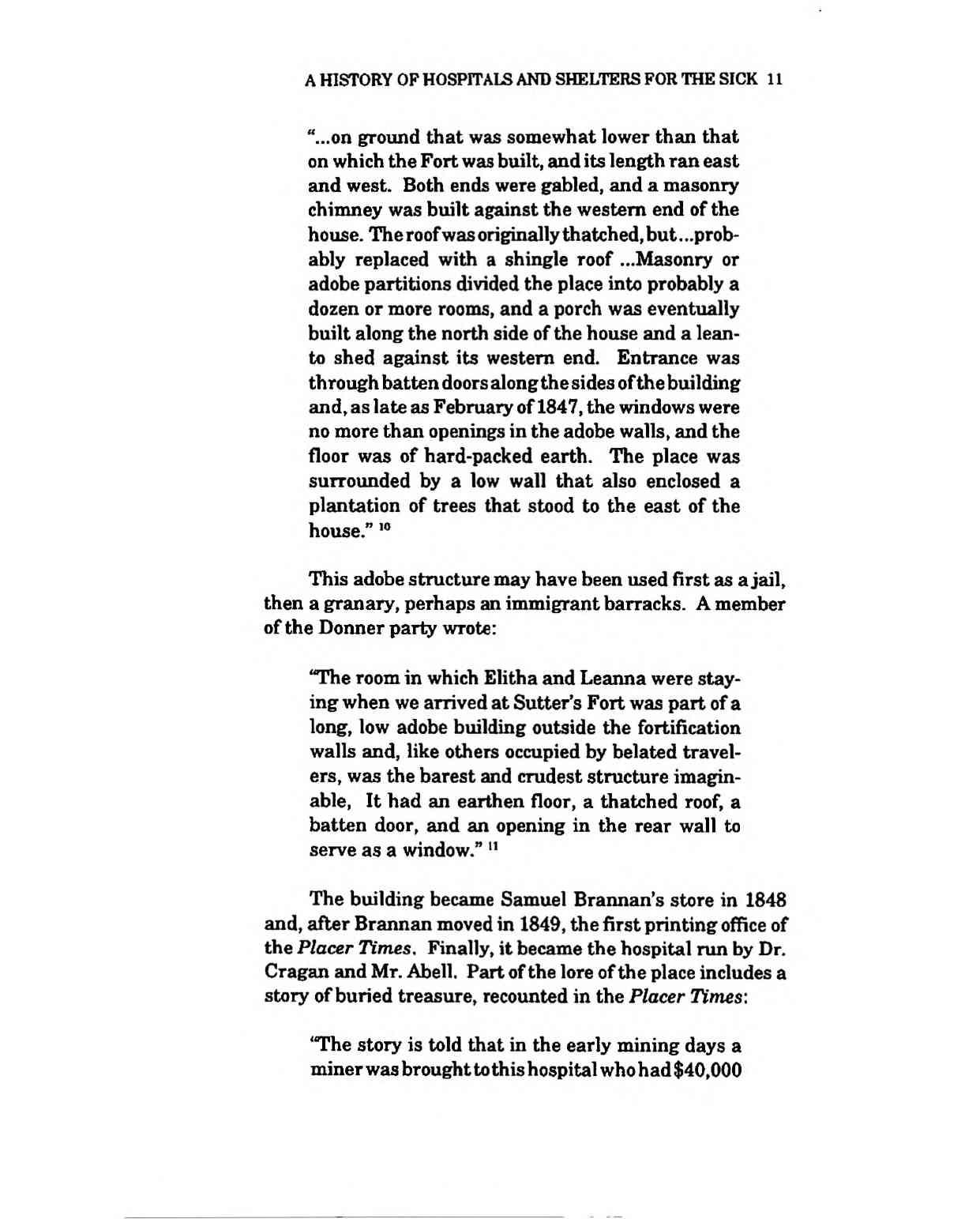
3 minute read
Adobe Hospital
Sutter had established an isolation ward for typhoid patients, but more space had tobe found for the desperately ill, so theBrannanstorein an oldadobebuildingnearthefort wasmadeintoahospital onAugust4,1849.7 Itwasrun until 1850byaDr. Cragin ofWashington, D.C., andaMr.Abell. A private room cost$16 a dayand the ward$10 aday. Surgery was extra.
This adobe hospital was also advertised in the San FranciscoAlta California forAugust4,1849. Thepublication stated that ithad been "thoroughly refitted,” was "spacious, cool, well ventilated,” and contained “a well ofmostexcellent water, lately found on the premises. Good nurses and attendantsandagoodcook willbeprovided,” and"nosickman [sic] will be refused admission because destitute ofmoney.” Dr. Cragin also offered "Drugs and Medicines,” including lime juice (as a prevention for scurvy), in his advertisement.9
The Placer Times describedthehospital as "Large, cool, andairy, apartfromthenoise, dust, andbustle ofthe cityand road, andfew,ifany, mosquitoestoannoy. Theveryentrance into the establishment where every attention and convenience is to be had, is enough to check the disease of an invalid.”9
Thisbuildinghadbeen erectedinthefall of1845, wasof one-story,andmeasuredapproximately30by 100feet. Itwas dividedintoroughly 14 compartmentswith acentralhallway. As described in The Early Inns ofCalifornia, 1844-69, it was located:
"...on ground that was somewhat lower than that on which theFortwasbuilt, anditslengthraneast and west. Both ends were gabled, and a masonry chimney was builtagainstthe western end ofthe house. Theroofwasoriginallythatched,but...probably replaced with a shingle roof ...Masonry or adobe partitions divided the place into probably a dozen or more rooms, and a porch was eventually builtalong the north side ofthe house and a leanto shed against its western end. Entrance was throughbattendoorsalongthesidesofthebuilding and,aslate as Februaryof1847, the windowswere no more than openings inthe adobe walls, andthe floor was of hard-packed earth. The place was surrounded by a low wall that also enclosed a plantation of trees that stood to the east of the house.” 10
This adobe structuremay have been used firstas ajail, then a granary, perhaps an immigrantbarracks. A member ofthe Donner party wrote:

'The roomin which ElithaandLeanna were stayingwhen we arrivedatSutter's Fort was part ofa long, low adobe building outside the fortification walls and, like others occupied by belated travelers, was the barest and crudest structure imaginable, It had an earthen floor, a thatched roof, a batten door, and an opening in the rear wall to serve as a window.” 11
The building became Samuel Brannan’s store in 1848 and, afterBrannan moved in 1849, thefirstprintingoffice of the Placer T'imes, Finally, it became the hospital run by Dr. Cragan andMr. Abell. Partofthe lore ofthe place includes a story ofburied treasure, recounted in the Placer Times:
'The story is told that in the early mining days a minerwasbroughttothishospitalwhohad$40,000
in gold dust. While delirious he escaped from attendants, carriedhis bags ofgold andburiedthe treasure, which has never been found to this day, although different parties have dug for the gold and for some time a dredger was operated in the vain hope oflocating the hidden wealth.” 12
In December 1849, when Dr. Robert M. Stansbury from NewJerseyboughtthehospital, thefeeschedulecontinuedto be $16 a day for private room and $10 for a ward, which covered “Board, lodging, medicines, medical and othernecessary attendance, and the washing ofbed linen and towels.” However, “Nopersonlaboringunderanyformofmaniawillbe received.” Itwascalledthe “Sacramento Hospital” andlasted through the cholera epidemic of 1850, when Dr. Stansbury diedofcholera onNovember 1. ItmaybethatDr.Stansbuiys “Sacramento Hospital” had become a public charity because Dr. Stansbury held the title of “Superintendent of the City Hospital” atthe time ofhis death.13
He had built an ll-by-25-foot extension onto the adobe at its northwest end. The Sacramento Transcript reported thathe also had builta house nearby into which some ofthe patientswere tobe moved.14 Itissupposedthatthisbuilding laterbecamethe“pesthouse”and wasmovedtothesouth side oftown.
OnOctober 1,1849,Drs.J.S.MartinandW.Dealopened a hospital inside thefort and offered low rates. Ayear later, onJuly22,1850, Dr. Deal advertisedarealestate office in the Transcript. 15











